INDOOR ACTIVITIES
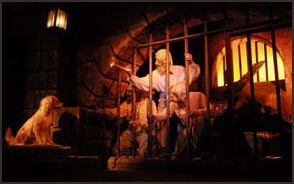
Pirates of the Caribbean at
Tokyo Disneyland Aikido: See Martial Arts.
Amusement Parks: Japan is home to roughly 400 amusement parks and theme parks. These includes large famous ones like Tokyo Disneyland and Universal Studios Japan, foreign villages and regular amusement parks. Many have fallen on hard times are struggling or have closed down. For information on Tokyo Disneyland and Universal Studios in Osaka see Tokyo and Osaka under Places. For others such as Space World in Kyushu, Fujikyu Highland Park near Mt. Fuji, Sabrio Puroland in Tokyo, the home of Hello Kitty, Parque Espana in Mie, near Nagoya, and Huis Ten Bosch in Nagasaki See Places.
Factory Tours in Japan
Many Japanese companies sponsor tours of their factories. Check their web sites. Toyota Kaikan Exhibition Hall (in Toyota near Nagoya) offers daily assembly line tours starting at 11:00am. Tour participants are bused to one of three plants in which Crowns, Priuses and 15 other Toyota passenger cars are assembled and walk along a walkway above the factory floor. Reservations are necessary. Call tel. (0565)-23-3922.
Asahi Beer's Suita (Osaka) and Nagoya breweries offers free tours. The Noritake Craft center in Nagoya. offers 1.5 hour tours in English at 10:00am and 1:00pm. You can see porcelain being made and take classes in brooch-making. Many craft makers in Kyoto offer tours.
Websites: Toyota factory tour Japan Guide ; Shizuoka (between Nagoya and Kyoto) factory tours hamamatsu-daisuki Others are listed if you google "Factory Tours in Japan."
Kawasaki City Tourist association offers twice-monthly factory night cruises of the city;s Keihin industrial zone . Marine Tourist Co, in Naka Ward Yokohama offers tours of the Yokohama indurtial zone,, Tours are also offered of the sprawling industrial zones of Yokkaichi, Mie Prefecture and Kitakyushu.

Toyota factory tour
Flower Arrangement in Japan
The main idea behind art of flower arranging (“ikebana”) is to arrange the flowers to heighten the appeal of a vase in a tea room and use flowers to represent heaven, earth and humanity. The tea ceremony and flower arranging have traditionally gone together hand and hand, with the objective of both being to express purity and simplicity rather than creating something of elegant beauty.
Today there are four main styles of flower arrangement: 1) “rikka” (standing flowers); 2) “nagarie” (throw in); 3) “moribana” (piled-up); and “shokai” (living flowers). Within these divisions there are hundreds of schools, the most well-known being Ikenobo, Ohara and Sogetsu.
Ikebana displays were originally used with the tea ceremony. Now Ikebana is a big business. Their schools have millions of students, many of whom are young women who are expected to learn the art to catch a worthy husband. Ikenobo School, (075)-351-8581, website: www.ikenobo.jp/. See Arts and Culture, Arts, Tea Ceremony and Flower Arranging.
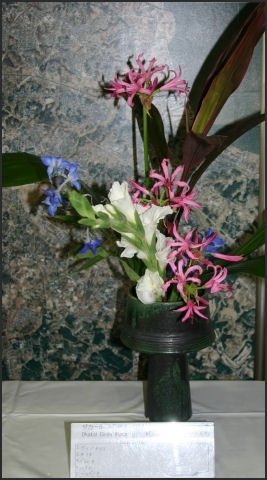
Gion Corner at Yasaka Kaikan Hall in Kyoto features a one-hour show with quick demonstrations of seven different traditional art forms: the tea ceremony, flower arranging, koto music, “gagaku” (ancient court music), “kyogen” (traditionally comic drama), bunraku puppet drama and geisha-style women dances. Shows in English are conducted twice daily at 8:00pm and 9:10pm March through November.Check with JNTO and local tourist offices for information in other places that offer flower arranging.
Websites: Ikebana International Ikebana International ; Flower arranging classes in Tokyo JNTO
Gambling and Casinos: There is no casino gambling Japan. There are pachinko parlors, lotteries, horse racing, bicycle racing, boat racing.
Handicapped Travel is somewhat developed in Japan. The airports and many buildings in Japan have elevators, ramps, wide doors and special bathrooms for handicapped people. Handicapped parking spaces are clearly marked. Many sidewalks, road crossings, intersections, stairways and train and subway station platforms have yellow strips with raised dots and dashes that help blind people navigate their way around and avoid injury.
Still, even with all this and a lot the high-tech gadgetry too, difficulties abound for handicapped people. Only 43 of Tokyo's 235 subway stations have elevators. In many cases wheelchair users have to page an attendant to carry them up and down the stairs. Blind people worry about getting hit by cars and falling off train station platforms. Website: Guide for wheelchair users Tesco-Premium
Health Clubs are usually found at expensive hotels. Sometimes guest memberships are available for visitors at local health clubs.
Hot Spring: See Onsens
Judo: See Martial Arts.
Karate: See Martial Arts.
Kendo: See Martial Arts.
Martial Arts: Karate: International Karate Organization,Kyokushinkaikan, tel. (03)-5992-7733, website: Kyokushinkaikan ; Judo: Kodokan Judo Institute website: All Japan Judo Federation. Kendo:All Japan Kendo Federation, tel. (03)-3234-6271, website: All Japan Kendo Federation. Aikido:Aikikai Foundation, tel. (03)-3203-9236, website: Aikikai Foundation.
Onsens in Japan
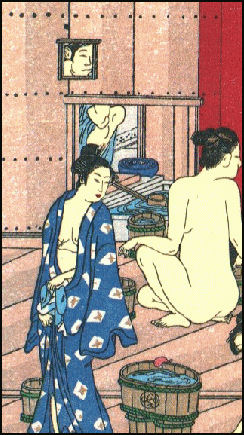
Japan has 19,445 thermal resorts and spas, known as onsens, scattered across the country and they welcome about 130 million people a year. There used to be more. Many of them offer mineral baths, health activities and massages. Unlike European spas people generally don't drink the water but bath in it (but some places do encourage visitors to drink it to). Many offer accommodation and meals.
Onsens offer a variety of baths and bathing experiences: individual, communal, inside, outside, mixed or single sex baths, cold baths, hot pools surrounded by trees and rocks, warm water swimming pools, black sand baths, mud baths, baths of graded temperatures, mineral baths, waterfalls, walking pools, cold pools, jacuzis, steam rooms, swimming pools with water slides, outdoor pool with bars, baths scented with small floating bags of citron and orange peel, and herbal baths.
Some onsens have baths that contain salt imported from the Dead Sea, allowing bathers to bob and float as of they were in the Dead Sea. Others have radioactive water with radon that is supposed to improve your health. Contradicting what many people think, one study in Japan found people who lived around a hot spring with high levels of radiation have lower cancer rates than the general population. Some onsen go to great length to get their water. Some of Tokyo's 144 hot spring wells pump from depths up to 1,700 meters underground
There are two kinds of baths: “notenburo” ("indoor baths") and “totemburo” ("outdoor bath"). Here are also baths only for men (“otoko-yu”), only for women (“omna-yu” and mixed gender ones (“konyoku”). The Japanese have a n expression for the social boding that takes place in a bath: “hadaka no tsukiai” ("naked companionship").
Hot springs have long been thought to have healing powers, There are stories of samurai bathing themselves after battles and farmers seeking them to cure their cuts and sore muscles, In the 19th century one the main goals of some early train lines was to make hot springs more accessible to the cities.

mixed sex bath Some baths have mineral waters that purportedly treat a host of illnesses. Some of the baths have clear water. Some have a reddish tint. Others are grayish. Each bath is said have curing powers for a different ailment. These baths often have the mineral content listed and the ailments that each mineral treats. Some of the nicest onsens have huge painting in the dressing rooms and feature cypress wood baths that give off a pleasing aroma when filed with hot water.
In the old days, men and women went nude in the mixed sex baths. That is no longer the case. Most of onsens have segregated indoor and outdoor baths for men and women. Some have a large outdoor bath (“rotenburo” ) where men and women can bath together in bathing suits or with a towel wrapped around them. But as a rule swimsuits are considered unsanitary.
In the Amoiri area you can still find mixed sex bathes where men and women bath naked together. In some other places mixed baths are making a come back and they get a surprising number of women. Although some of them complain about alligators (men who cruise around they baths with their eyes just above the surface of the water, checking out women' bodies).

bath in Beppu Onsen Accommodation: Onsens usually offer accommodation and meals. Ends to themselves they usually have several baths and are popular weekend trip destinations, particularly for women. Many resemble large hotels and have indoor baths. Other are more like country inns and have indoor and outdoor bathing facilities. Some baths are reached only after taking a hike through the mountains.
Some are quite luxurious: filled with artworks and an army unIformed employees relentlessly saying "excuse me" and "thank you" for this and that. Prices range from $70 to $500 per person per night, including a large dinner and small breakfast. Day trippers who don't spend the night are charged between $5 and $10.
The room are often simple Japanese-style room with tatami mats and a low table and futons that are unfurled at night. The meals are set and offered at a specific time. Often times onsens meals are served in the guest's room. They often contain a variety of vegetable, pickle and fish dishes, served artistically in small amounts.
Many onsens have transfer service from the trains stations. This is usually in the form a small van that picks up guest outside the station and take them to the mountains where the onsen is located. Once guest arrive they shed their clothes and put on bathrobe-like yukatas and are given towels. Many onsens in the mountains have hiking trails around the facility. Guests squeeze in hikes between meals and baths. Many are open late into the night and allow guest to drink sake while they are taking a soak.
Onsens Etiquette: See Baths, Hygiene
Onsens Troubles: A study found that even though most onsens claim to be natural hot springs, 70 percent use water that is pumped up from underground. Only 30 percent were real hot springs in which natural water bumbles to the surface. So much water is in being pumped from underground there are worries it may dry up hot spring water supplies.
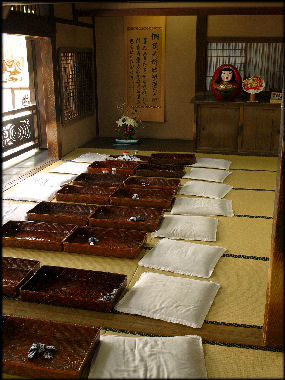
relaxing room In one survey a third of the onsens admitted they diluted the hot spring water with tap water. Half said they recycled water through filters and 40 percent failed to respond. Other studies and research have uncovered onsens that had water trucked in from other places, or ran it over mineral ores so it could be labeled as mineral water. Others have dangerous bacteria. At one Onsens in Miyazaki Prefecture, 295 bathers became ill and seven died from a mass legionella infection caused by contaminated water.
In 2003, it was revealed that one onsen famed for its milky-white water added a powder to the water to give it the milky color. Further investigation found that several other onsens used similar tactics to give their water unique colors or characteristics. In some cases the onsens originally had uniquely colored water but after supplies began running low additives were added out of fear that tourist would no longer come. In recent years an effort has been to regulate the onsen industry so that onsen live up to their claims. Some that has added tap water ir run misleading ads have been criminally charged.
Revelations of water tampering have hurt an industry that was already in a state of decline. Some people with reservations have called and demanded their money back. Onsens that didn't tamper with their water have been hurt as much as those that did. A couple onsens were shut down after police raids. Onsens are currently closing at a rate of 100 a year.
Popular Onsens: The most popular Onsens areas accessible to Tokyo include Atami and Shomoda on the Izu Peninsula, Kusatsi in Gunma, Kinugawa in Tochigi, and Hakone in Kanagawa. Popular onsens in the Kansai area include the Kurama Onsens near Kyoto and Ashima Onsens near Kobe. In Kyushu there are many hot springs in Beppu and Kagoshima. See Places
Book: “A Guide to Japanese Hot Springs” by Anne Hotta (Kodansha, 1986) and “Japan's Hidden Hot Springs” by Robert Neff (Tuttle, 1986). For more information try Japan Spa Association (tel. 03-3231-1640, Spa.org )
Websites: Good Onsen List with Pictures Japanese Guesthouse Onsen Map with Mixed Sex baths Secret Onsen ; Onsen Guide Hot Springs Michelin ;
Pets can not be brought into Japan by visitors.
Rugby is a popular spectator sports in Japan. University games and company team matches sometimes draw large crowds. The games are held mostly in the fall during the weekends.
Sake Tasting in Japan
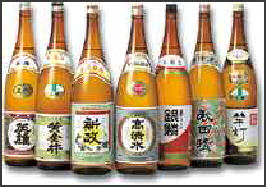
Akita sake Sake tasting tours are offered in sake-making areas. Sake breweries around Tokyo that offer tours on a reservation basis include: 1) Tsuchiya Brewery in Komae (10 minute walk from Odakyu Kitami Station, tel.03-3489-4752); 2) Ishikawa Brewery in Fussa (15 minute walk from JR Haijimi Station, tel. 042-553-0100), with restaurants, a garden and sake museum;
3) Tamura Brewery in Fussa (15 minute walk from JR Fussa Station, tel. 042-551-0003); 4) Watanabe Brewery in Musashi-Murayama (10 minutes by bus from Kamikitadai Station on Tama Monorail, tel. 0425-62-3131); 5) Nishioka Brewery in Hachioji (15 minute walk from JR Nishi-Hachioji Station, tel. 0426-25-0052);
6) Nakamura Brewery in Akiruno (15 minute walk from JR Akigawa Station, tel. 0425-58-0516); 7) Toshimaya Brewery in Higshi-Murayama (10 minute walk from Higshi-Murayama Station on the Seibu-Shinjuku Line, tel. 0423-91-0601). 8) Ozawa Brewery in One (near JR Sawai Station, tel. 0428-78-8215), with restaurants, gardens and a sake-tasting bar. See Sake
Gekkeikan Sake Brewery Tour in Fushimi near Kyoto is sponsored by the world's leading producer of sake at old traditionally warehouse. The tours are in Japanese. There are 37 sake breweries in the Fushimi area. Most Gekkeikan sake is made at a large modern facility on Osaka.
The Nada district of Kobe is perhaps Japan's most famous sake production area. Nine sake breweries offer tours The one at Shushinkan is recommended. They have an introductory video in English and serve a seven-dish lunch with aperitif made of the local sake for only $11. The tour includes a visit to the cedar-lined room used to ferment the rice. Nishinomiya is another famous sake-brewing district.The water there comes from a famous aquifer.
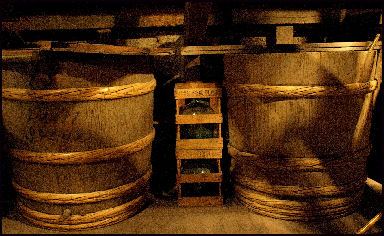
mixing area in a sake brewery Niigata Prefecture is known for producing Japan's best rice and sake. Aizu-Wakamatsu (175 miles north of Tokyo) is an old castle town with many old merchant houses where you can sample local sakes by doing a brewery hop. Many of the town's 13 sake breweries are located near one another in the downtown area. Takayama (2.5hours north of Nagoya) is city with 66,000 people with narrow streets lined with traditional sake cellars, miso shops, stores, well-preserved merchant houses, and sake breweries. Websites: Google "sake tours Japan" and some places turn up.
Scenic Railways include the 1)Sagano Scenic Train (JR San-in line from Kyoto Station) is tourist railway that follows the Hozugawa River Gorge and was opened in 1991. The trip is short and expensive but popular during the spring cherry-viewing and fall maple-leaf viewing season. The passenger cars have roofs but are open and the sides. May people get off in Kameoka and return on the popular river ride.2)
Hakone-Tozan Railway (starting at Gora near Hakone in the Mt. Fuji Area) is two-car train that climbs a mountain slope by repeatedly changing direction and going back and forth up a series of switchbacks. The ride is especially beautiful in late June and early July when 8,000 hydrangea plant along the route are in full bloom.
Spas: See Onsens
Sumo : Japan Sumo Association (Nihon Sumo Kyokai) 1-3-28 Yokozuna, Sumida-ku, Tokyo 130, Japan (81-3-2623, fax: 81-3-2623-53000. Websites: Nihon Sumo Kyokai official site sumo.or ; Sumo ticketssumo.or tickets
Tea Ceremony in Japan
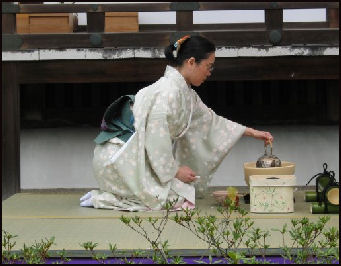
The tea ceremony, known in Japan as “chanoyo” or “sado”, is unique to Japan and one of country's most famous cultural traditions. It is an art form that incorporates various elements of Japanese culture such as Zen Buddhism, flower arrangement, ceramics, architecture, calligraphy, social etiquette and food. “Chanyo” means "way of the tea."
In the traditional tea ceremony every movement is graceful and understated and carried out according with highly stylized etiquette. Newcomers often find the process tedious and uncomfortable. Connoisseurs insist it takes years of practice and training to fully appreciate and decades to learn all the responsibilities of the tea master.
Tea ceremony participants are expected to sit with their backs straight, their feet tucked under their butts a precise distance from the edge of the tatami mat, with their eyes caste downward. To the uninitiated this position can be uncomfortable for short period and torture if held for 15 minutes or more.
The participants are encouraged to relax and meditate on their surroundings and the craftsmanship of the tea utensils. Sometimes small cakes, sweets or snacks are offered to guests. These are eaten before tea with a pick-like utensils called a “kuromoji” are designed to encourage reflecting upon the seasons.
The key elements of the tea ceremony include: 1) measuring of powdered green tea into a bowl with a bamboo spoon; 2) poring the water with a ladle dipped in a kettle heated over a charcoal fire; 3) whisking of the tea into a creamy foam with a bamboo whisk; 4) serving the guests one at a time in formal movements; and 5) turning the cup to admire the beauty and texture of the tea before you drink it. After the tea is prepared it is passed down the line to drinkers. Monks traditionally cup the bowl in their hands while kneeling and drink the hot liquid in three slow swallows.
Michelle Green, who attended a tea ceremony as a tourist, wrote in the New York Times, ¡°We kneeled facing one another across an enormous kettle on a brazier. Like a priestess, Ms. Fujii drew a small kit from the front of her kimono and extracted a bit of silk in which she purified the lacquerware tea container, the long-handed bamboo spoon, the spider-like whisk."
" 
With a shallow spoon, Ms. Fuji tapped green matcha into a bowl selected for its quiet beauty. A stream of boiling water turned the powder into a pea-colored liquid that she whisked into a froth. Fast, then slower, in a prescribed motion; only the right hand, never the left. She issued invitations and cued my responses as they were lines in a play...As I held the bowl of tea that she had made for me and drank deeply, my teacher remained silent so I could take in the sharp fragrance and the creamy, bitter taste,¡± When its over one bows.
There are 10 major tea ceremony schools with 5 million followers nationwide. The details of each school vary slightly and may be different from the description provides here. There are three main Senke schools, inspired by Sen ni Rikkyu: Ura, Omete and Muskakoji. Other influential schools include Enshu, Yabunouch and Sohen. To be able to present the tea ceremony one has to take a three-year course. After graduating one receives a licence and tea name.
A number of places in Japan offer tourist the chance to participate in a tea ceremony.Gion Corner at Yasaka Kaikan Hall in Kyoto features a one-hour show with quick demonstrations of seven different traditional art forms: the tea ceremony, flower arranging, koto music, “gagaku” (ancient court music), “kyogen” (traditionally comic drama), bunraku puppet drama and geisha-style women dances. Shows in English are conducted twice daily at 8:00pm and 9:10pm March through November. Check with JNTO and local tourist offices for information in other places that offer the tea ceremony.
Also contact Urasenke School, (075)-431-3111, website: Urasenke . Ogasawara Sencha Service School, (0797)-22-5405, website: Ogasawara
Websites: Tea ceremony for English speakers in Tokyo JNTO ; Tea ceremony in Kyoto Kyoto Travel Guide
Image Sources: 1) Tokyo Disneyland 2) Toyota 3) Nicolas Delerue 4) Torii Kiyonaga 5) Onsen Express 6) Japanese Guest Houses 7) 9) Ray Kinnane 8) Akita City 10) Wiki Common 11) Asian Art Mall
Text Sources: New York Times, Washington Post, Los Angeles Times, Daily Yomiuri, Times of London, Japan National Tourist Organization (JNTO), National Geographic, The New Yorker, Time, Newsweek, Reuters, AP, Lonely Planet Guides, Compton¡¯s Encyclopedia and various books and other publications.
